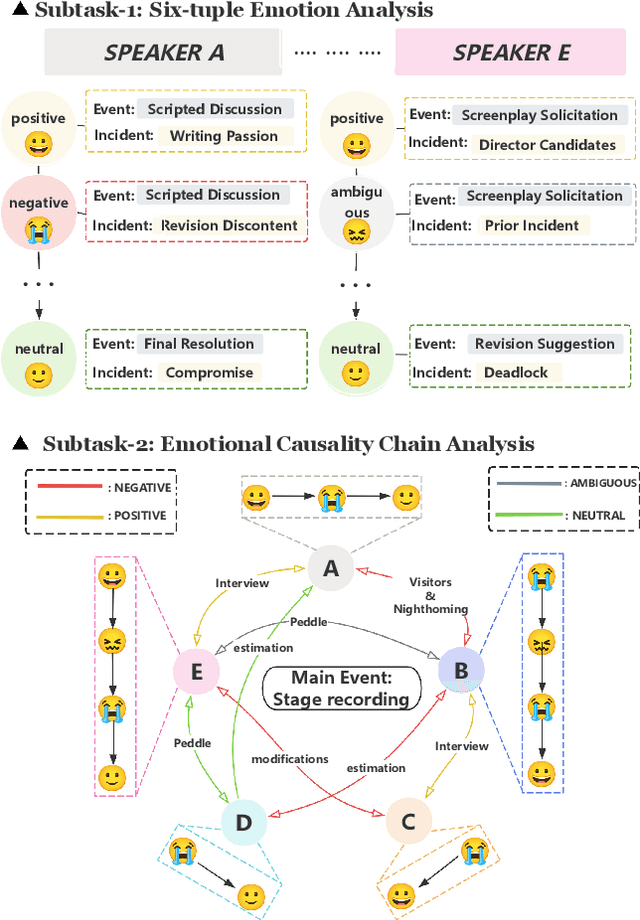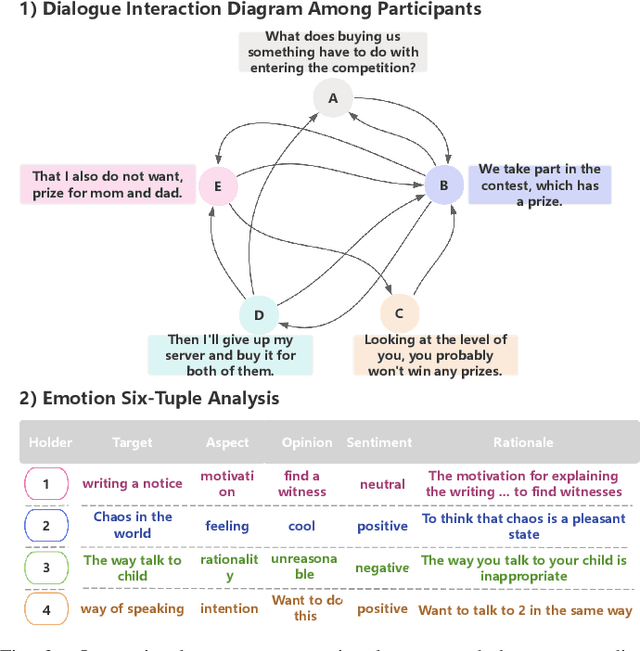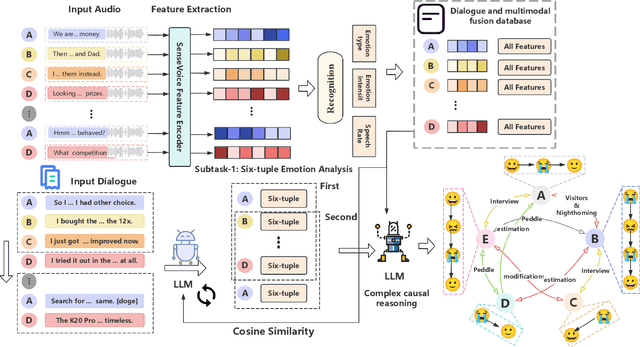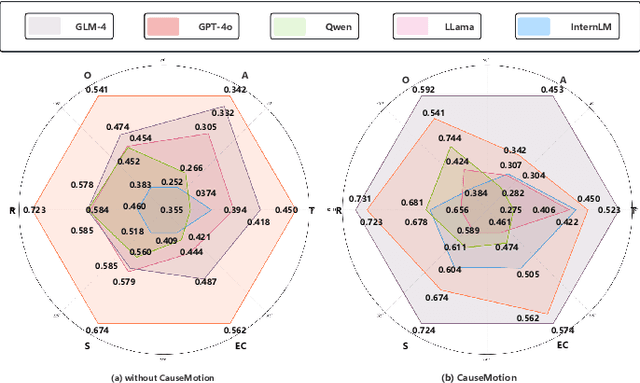Yulong Li
Rhythm of Opinion: A Hawkes-Graph Framework for Dynamic Propagation Analysis
Apr 21, 2025Abstract:The rapid development of social media has significantly reshaped the dynamics of public opinion, resulting in complex interactions that traditional models fail to effectively capture. To address this challenge, we propose an innovative approach that integrates multi-dimensional Hawkes processes with Graph Neural Network, modeling opinion propagation dynamics among nodes in a social network while considering the intricate hierarchical relationships between comments. The extended multi-dimensional Hawkes process captures the hierarchical structure, multi-dimensional interactions, and mutual influences across different topics, forming a complex propagation network. Moreover, recognizing the lack of high-quality datasets capable of comprehensively capturing the evolution of public opinion dynamics, we introduce a new dataset, VISTA. It includes 159 trending topics, corresponding to 47,207 posts, 327,015 second-level comments, and 29,578 third-level comments, covering diverse domains such as politics, entertainment, sports, health, and medicine. The dataset is annotated with detailed sentiment labels across 11 categories and clearly defined hierarchical relationships. When combined with our method, it offers strong interpretability by linking sentiment propagation to the comment hierarchy and temporal evolution. Our approach provides a robust baseline for future research.
ScalingNoise: Scaling Inference-Time Search for Generating Infinite Videos
Mar 20, 2025Abstract:Video diffusion models (VDMs) facilitate the generation of high-quality videos, with current research predominantly concentrated on scaling efforts during training through improvements in data quality, computational resources, and model complexity. However, inference-time scaling has received less attention, with most approaches restricting models to a single generation attempt. Recent studies have uncovered the existence of "golden noises" that can enhance video quality during generation. Building on this, we find that guiding the scaling inference-time search of VDMs to identify better noise candidates not only evaluates the quality of the frames generated in the current step but also preserves the high-level object features by referencing the anchor frame from previous multi-chunks, thereby delivering long-term value. Our analysis reveals that diffusion models inherently possess flexible adjustments of computation by varying denoising steps, and even a one-step denoising approach, when guided by a reward signal, yields significant long-term benefits. Based on the observation, we proposeScalingNoise, a plug-and-play inference-time search strategy that identifies golden initial noises for the diffusion sampling process to improve global content consistency and visual diversity. Specifically, we perform one-step denoising to convert initial noises into a clip and subsequently evaluate its long-term value, leveraging a reward model anchored by previously generated content. Moreover, to preserve diversity, we sample candidates from a tilted noise distribution that up-weights promising noises. In this way, ScalingNoise significantly reduces noise-induced errors, ensuring more coherent and spatiotemporally consistent video generation. Extensive experiments on benchmark datasets demonstrate that the proposed ScalingNoise effectively improves long video generation.
MSWAL: 3D Multi-class Segmentation of Whole Abdominal Lesions Dataset
Mar 17, 2025Abstract:With the significantly increasing incidence and prevalence of abdominal diseases, there is a need to embrace greater use of new innovations and technology for the diagnosis and treatment of patients. Although deep-learning methods have notably been developed to assist radiologists in diagnosing abdominal diseases, existing models have the restricted ability to segment common lesions in the abdomen due to missing annotations for typical abdominal pathologies in their training datasets. To address the limitation, we introduce MSWAL, the first 3D Multi-class Segmentation of the Whole Abdominal Lesions dataset, which broadens the coverage of various common lesion types, such as gallstones, kidney stones, liver tumors, kidney tumors, pancreatic cancer, liver cysts, and kidney cysts. With CT scans collected from 694 patients (191,417 slices) of different genders across various scanning phases, MSWAL demonstrates strong robustness and generalizability. The transfer learning experiment from MSWAL to two public datasets, LiTS and KiTS, effectively demonstrates consistent improvements, with Dice Similarity Coefficient (DSC) increase of 3.00% for liver tumors and 0.89% for kidney tumors, demonstrating that the comprehensive annotations and diverse lesion types in MSWAL facilitate effective learning across different domains and data distributions. Furthermore, we propose Inception nnU-Net, a novel segmentation framework that effectively integrates an Inception module with the nnU-Net architecture to extract information from different receptive fields, achieving significant enhancement in both voxel-level DSC and region-level F1 compared to the cutting-edge public algorithms on MSWAL. Our dataset will be released after being accepted, and the code is publicly released at https://github.com/tiuxuxsh76075/MSWAL-.
Granite Embedding Models
Feb 27, 2025Abstract:We introduce the Granite Embedding models, a family of encoder-based embedding models designed for retrieval tasks, spanning dense-retrieval and sparse retrieval architectures, with both English and Multilingual capabilities. This report provides the technical details of training these highly effective 12 layer embedding models, along with their efficient 6 layer distilled counterparts. Extensive evaluations show that the models, developed with techniques like retrieval oriented pretraining, contrastive finetuning, knowledge distillation, and model merging significantly outperform publicly available models of similar sizes on both internal IBM retrieval and search tasks, and have equivalent performance on widely used information retrieval benchmarks, while being trained on high-quality data suitable for enterprise use. We publicly release all our Granite Embedding models under the Apache 2.0 license, allowing both research and commercial use at https://huggingface.co/collections/ibm-granite.
FACTR: Force-Attending Curriculum Training for Contact-Rich Policy Learning
Feb 24, 2025Abstract:Many contact-rich tasks humans perform, such as box pickup or rolling dough, rely on force feedback for reliable execution. However, this force information, which is readily available in most robot arms, is not commonly used in teleoperation and policy learning. Consequently, robot behavior is often limited to quasi-static kinematic tasks that do not require intricate force-feedback. In this paper, we first present a low-cost, intuitive, bilateral teleoperation setup that relays external forces of the follower arm back to the teacher arm, facilitating data collection for complex, contact-rich tasks. We then introduce FACTR, a policy learning method that employs a curriculum which corrupts the visual input with decreasing intensity throughout training. The curriculum prevents our transformer-based policy from over-fitting to the visual input and guides the policy to properly attend to the force modality. We demonstrate that by fully utilizing the force information, our method significantly improves generalization to unseen objects by 43\% compared to baseline approaches without a curriculum. Video results and instructions at https://jasonjzliu.com/factr/
MMRC: A Large-Scale Benchmark for Understanding Multimodal Large Language Model in Real-World Conversation
Feb 17, 2025Abstract:Recent multimodal large language models (MLLMs) have demonstrated significant potential in open-ended conversation, generating more accurate and personalized responses. However, their abilities to memorize, recall, and reason in sustained interactions within real-world scenarios remain underexplored. This paper introduces MMRC, a Multi-Modal Real-world Conversation benchmark for evaluating six core open-ended abilities of MLLMs: information extraction, multi-turn reasoning, information update, image management, memory recall, and answer refusal. With data collected from real-world scenarios, MMRC comprises 5,120 conversations and 28,720 corresponding manually labeled questions, posing a significant challenge to existing MLLMs. Evaluations on 20 MLLMs in MMRC indicate an accuracy drop during open-ended interactions. We identify four common failure patterns: long-term memory degradation, inadequacies in updating factual knowledge, accumulated assumption of error propagation, and reluctance to say no. To mitigate these issues, we propose a simple yet effective NOTE-TAKING strategy, which can record key information from the conversation and remind the model during its responses, enhancing conversational capabilities. Experiments across six MLLMs demonstrate significant performance improvements.
Beyond Words: AuralLLM and SignMST-C for Precise Sign Language Production and Bidirectional Accessibility
Jan 01, 2025Abstract:Although sign language recognition aids non-hearing-impaired understanding, many hearing-impaired individuals still rely on sign language alone due to limited literacy, underscoring the need for advanced sign language production and translation (SLP and SLT) systems. In the field of sign language production, the lack of adequate models and datasets restricts practical applications. Existing models face challenges in production accuracy and pose control, making it difficult to provide fluent sign language expressions across diverse scenarios. Additionally, data resources are scarce, particularly high-quality datasets with complete sign vocabulary and pose annotations. To address these issues, we introduce CNText2Sign and CNSign, comprehensive datasets to benchmark SLP and SLT, respectively, with CNText2Sign covering gloss and landmark mappings for SLP, and CNSign providing extensive video-to-text data for SLT. To improve the accuracy and applicability of sign language systems, we propose the AuraLLM and SignMST-C models. AuraLLM, incorporating LoRA and RAG techniques, achieves a BLEU-4 score of 50.41 on the CNText2Sign dataset, enabling precise control over gesture semantics and motion. SignMST-C employs self-supervised rapid motion video pretraining, achieving a BLEU-4 score of 31.03/32.08 on the PHOENIX2014-T benchmark, setting a new state-of-the-art. These models establish robust baselines for the datasets released for their respective tasks.
Decoding the Flow: CauseMotion for Emotional Causality Analysis in Long-form Conversations
Jan 01, 2025



Abstract:Long-sequence causal reasoning seeks to uncover causal relationships within extended time series data but is hindered by complex dependencies and the challenges of validating causal links. To address the limitations of large-scale language models (e.g., GPT-4) in capturing intricate emotional causality within extended dialogues, we propose CauseMotion, a long-sequence emotional causal reasoning framework grounded in Retrieval-Augmented Generation (RAG) and multimodal fusion. Unlike conventional methods relying only on textual information, CauseMotion enriches semantic representations by incorporating audio-derived features-vocal emotion, emotional intensity, and speech rate-into textual modalities. By integrating RAG with a sliding window mechanism, it effectively retrieves and leverages contextually relevant dialogue segments, thus enabling the inference of complex emotional causal chains spanning multiple conversational turns. To evaluate its effectiveness, we constructed the first benchmark dataset dedicated to long-sequence emotional causal reasoning, featuring dialogues with over 70 turns. Experimental results demonstrate that the proposed RAG-based multimodal integrated approach, the efficacy of substantially enhances both the depth of emotional understanding and the causal inference capabilities of large-scale language models. A GLM-4 integrated with CauseMotion achieves an 8.7% improvement in causal accuracy over the original model and surpasses GPT-4o by 1.2%. Additionally, on the publicly available DiaASQ dataset, CauseMotion-GLM-4 achieves state-of-the-art results in accuracy, F1 score, and causal reasoning accuracy.
Bimanual Dexterity for Complex Tasks
Nov 20, 2024Abstract:To train generalist robot policies, machine learning methods often require a substantial amount of expert human teleoperation data. An ideal robot for humans collecting data is one that closely mimics them: bimanual arms and dexterous hands. However, creating such a bimanual teleoperation system with over 50 DoF is a significant challenge. To address this, we introduce Bidex, an extremely dexterous, low-cost, low-latency and portable bimanual dexterous teleoperation system which relies on motion capture gloves and teacher arms. We compare Bidex to a Vision Pro teleoperation system and a SteamVR system and find Bidex to produce better quality data for more complex tasks at a faster rate. Additionally, we show Bidex operating a mobile bimanual robot for in the wild tasks. The robot hands (5k USD) and teleoperation system (7k USD) is readily reproducible and can be used on many robot arms including two xArms (16k USD). Website at https://bidex-teleop.github.io/
RoomDiffusion: A Specialized Diffusion Model in the Interior Design Industry
Sep 05, 2024Abstract:Recent advancements in text-to-image diffusion models have significantly transformed visual content generation, yet their application in specialized fields such as interior design remains underexplored. In this paper, we present RoomDiffusion, a pioneering diffusion model meticulously tailored for the interior design industry. To begin with, we build from scratch a whole data pipeline to update and evaluate data for iterative model optimization. Subsequently, techniques such as multiaspect training, multi-stage fine-tune and model fusion are applied to enhance both the visual appeal and precision of the generated results. Lastly, leveraging the latent consistency Distillation method, we distill and expedite the model for optimal efficiency. Unlike existing models optimized for general scenarios, RoomDiffusion addresses specific challenges in interior design, such as lack of fashion, high furniture duplication rate, and inaccurate style. Through our holistic human evaluation protocol with more than 20 professional human evaluators, RoomDiffusion demonstrates industry-leading performance in terms of aesthetics, accuracy, and efficiency, surpassing all existing open source models such as stable diffusion and SDXL.
 Add to Chrome
Add to Chrome Add to Firefox
Add to Firefox Add to Edge
Add to Edge